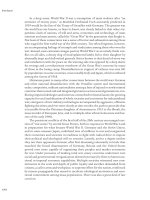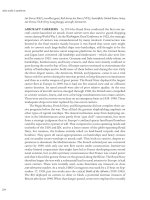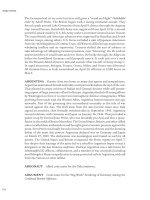The concise encyclopedia of world war II 2 volumes (greenwood encyclopedias of modern world wars) ( PDFDrive ) 965
Bạn đang xem bản rút gọn của tài liệu. Xem và tải ngay bản đầy đủ của tài liệu tại đây (85.88 KB, 1 trang )
OKL
The Japanese counterattacked on May 4, then withdrew to an even deeper set of
fortifications on Oroku. The fighting was close and intense, with flamethrowers an
essential weapon used to winnow out bitterender resistance. On June 22 Okinawa
was formally declared secure. Over the course of the land battle the Japanese lost an
astonishing 7,800 planes, and a lesser number of pilots. Over 7,000 U.S. troops died
in their bloodiest battle of the Pacific War. The Americans took 49,000 total casualties, including 4,907 sailors killed or wounded by kamikaze, the highest loss rate in
any battle of the war. Japan lost 107,539 military dead, over one-quarter of whom
were blasted or incinerated to death or sealed inside caves. About 11,000 Japanese
military prisoners were taken, first truly significant Japanese surrender in the Pacific War. About one quarter of all civilians on the island also died, some 75,000
souls in all. Many had been encouraged—and some were forced—by Japanese officers to seal themselves in death caves or to hurl their children and themselves into
the sea. The death agony of whole families was captured on fi lm.
See also Hiroshima; Nimitz, Chester.
Suggested Reading: E. B. Sledge, With the Old Breed: At Peleliu and Okinawa (1981;
2007).
OKL
“Oberkommando der Luftwaffe.” German Air Force High Command.
OKM
“Oberkommando der Kriegsmarine.” German Navy High Command.
OKW “Oberkommando der Wehrmacht.” German Armed Forces High Command. The overarching headquarters of the German armed forces, comprising all
three services: Heer (Army), Kriegsmarine (Navy), and Luftwaffe (Air Force). It was
established in 1938 when Adolf Hitler purged the Wehrmacht of top generals who
opposed his aggressive war plans. OKW was supposed to work on grand strategy, but
it never developed one. Instead, from the onset Hitler merged political and military
authority in his own person while consulting on operational matters, planning for
which became the main function of OKW. He thus reduced the military leadership
to little more than a technical elite without a policy role. Nevertheless, within that
context the strategic policies Hitler pursued usually enjoyed support from top
military men. From 1938 to 1945 the key officer was Wilhelm Keitel. The “Wehrmachtsfuehrungsstab” (Armed Forces Operations Staff, or WFST), was headed by
Alfred Jodl. It advised on operations until Hitler took over direction even of detailed
field movements, as well as what remained of strategy late in the war. OKW oversaw only the southern and western fronts during the second half of the war, while
Hitler personally and the OKH (“Oberkommando des Heeres.”) took charge of the
Soviet or Eastern Front. The Luftwaffe remained largely independent of the OKW
due to the political clout of Hermann Göring with Hitler and within Nazi circles,
though that was a waning reality from 1942 to 1945.
In December 1941, upon the failure of BARBAROSSA and in the midst of the
great Soviet counteroffensive in front of Moscow, Hitler took personal charge
of OKW as his own commander in chief and director of operations. However, it
812









